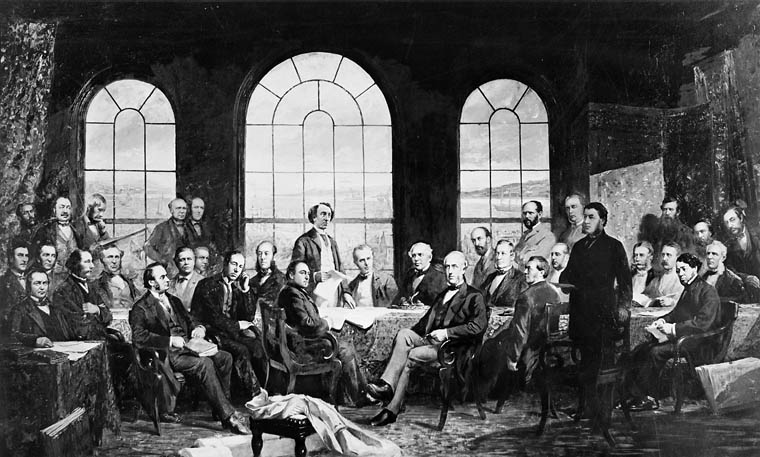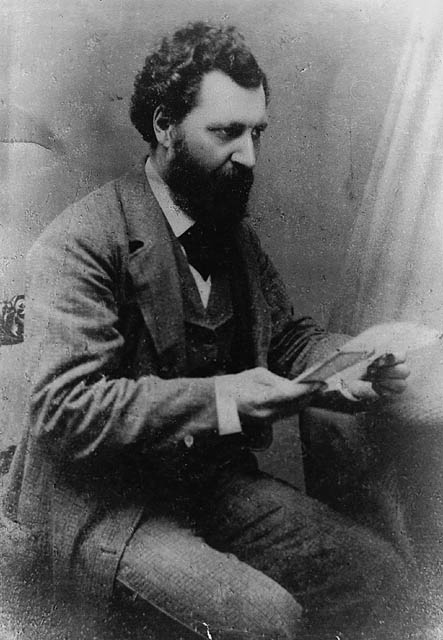
Other Key Figures in Confederation
Notably, several delegates considered to be Fathers of Confederation attended only one or two of the conferences. The representatives from Prince Edward Island and Newfoundland ultimately declined to enter Confederation. (PEI joined in 1873 and Newfoundland and Labrador in 1949.)
The wives and daughters of the original 36 men have also been described as the Mothers of Confederation. They played an important role in the social gatherings that were a vital part of the Charlottetown, Quebec and London Conferences. Sir John A. Macdonald is commonly viewed as the chief architect of Confederation. But academics, journalists and heritage groups have argued for the prominence of other figures, such as George Brown and Sir George-Étienne Cartier.
Charlottetown Conference (1864)
The Charlottetown Conference (1–9 September 1864) was intended to be about the possible union of the Maritime colonies. After representatives from the Province of Canada asked to be included, the discussion expanded to include a union of all of British North America. Newfoundland was asked to take part, but its invitation arrived too late for the colony to send a delegation. The conference was noteworthy for the lavish banquets and balls that accompanied the discussions. The delegates agreed in principle to the proposed union that was presented by the Province of Canada. Another conference was scheduled for the following month in Quebec City.
Quebec Conference (1864)
At the Québec Conference (10–27 October 1864), delegates discussed the specific details of the proposed Confederation that was agreed upon at Charlottetown. The result was the 72 Quebec Resolutions. They formed the basis of Canada’s Constitution.
Prince Edward Island and Newfoundland rejected the resolutions. Nova Scotia, New Brunswick and the Province of Canada were the only remaining supporters. Delegates from New Brunswick and Nova Scotia, however, faced significant opposition from within their own provinces. (See also: Confederation’s Opponents; Repeal Movement.)
London Conference (1866–67)
At the London Conference (4 December 1866 to March 1867), 16 delegates representing Nova Scotia, New Brunswick and the Province of Canada met in England to draft the British North America Act. The Act was based on the 72 Resolutions established at the Quebec Conference. The Act made minor concessions to the Maritime Provinces. It also made provisions for the future inclusion of Prince Edward Island, Newfoundland, the North-West Territories and British Columbia.
Joseph Howe of Nova Scotia was also present in London as part of an anti-union delegation. ( See also Confederation’s Opponents.) Despite that, the British North America Act easily passed through British Parliament. It was signed into law by Queen Victoria on 29 March 1867.
Manitoba Is Created (1870)
Louis Riel, the leader of the Red River Resistance, is often cited as Manitoba’s Father of Confederation. In 1869, the Canadian government negotiated an agreement to purchase Rupert’s Land from the Hudson’s Bay Company. However, the Métis of the Red River Colony were not consulted. They worried that their rights would be ignored in the transfer.
Under the leadership of Louis Riel, the Métis seized control of the Upper Fort Garry trading post. They declared a provisional government and sent delegates to Ottawa to negotiate the Red River Colony’s entry into Confederation. The Canadian government was forced to give in to Métis demands. In May 1870, the new province of Manitoba was created through the Manitoba Act. The act also granted the Métis title to their lands along the Red and Assiniboine rivers. They also received another 1.4 million acres for their descendants as well as guaranteed French and Catholic linguistic and religious rights. Despite this victory, Louis Riel was denied amnesty for leading an uprising against the Canadian government. He was forced to flee to the United States and was later executed.
On 10 March 1992, Parliament passed a unanimous resolution that named Louis Riel the founder of Manitoba. In the House of Commons, MP Joe Clark announced that “it is now time to recognize the very important and constructive role Louis Riel played in defending the interests of the Métis people and contributing to the political development of the West and of Canada.”
(See also Manitoba and Confederation.)

British Columbia Joins Confederation (1871)
The figure most associated with British Columbia’s entry into Confederation is Amor de Cosmos. As a member of the Legislative Council of British Columbia, he introduced a resolution as early as March 1867 calling for the province’s inclusion in Confederation. In May 1868, de Cosmos helped found the Confederation League. Its goal was to raise public support for a union with Canada. In 1870, he took part in the “Great Confederation Debates.” They resulted in the Legislative Council voting to send a delegation to Ottawa to negotiate the province’s entry into Confederation.
(See also British Columbia and Confederation.)
Newfoundland Joins Confederation (1949)
During the Great Depression, Newfoundland was crippled by debt. To help in its economic reorganization, a commission government was established on 16 February 1934. A governor acted on the advice of six commissioners. They were all appointed by the British government. After the Second World War reinvigorated the local economy, Newfoundlanders called for the re-establishment of responsible government.
The British government formed the National Convention in 1946. It included 45 elected delegates from across Newfoundland and Labrador. They studied the forms of government that would replace the commission. Two main factions emerged. Those who advocated for responsible government were led by Peter Cashin. Those who wanted union with Canada were led by Joey Smallwood.

The convention scheduled a referendum on Newfoundland’s political future. It took place on 3 June 1948. The Confederate Association, the Responsible Government League and the Economic Union Party (which supported annexation by the United States) all campaigned for their desired outcomes. The results of the first referendum were inconclusive. The responsible government group won but did not receive a clear majority. But supporters of union with Canada won the second referendum on 22 July 1948. They cast 78,323 votes (52.3 per cent) compared to 71,334 votes (47.7 per cent) for independence. An amendment to the British North America Act (referred to as the Newfoundland Act) finalized the arrangements.
As a passionate advocate for confederation, Smallwood was dubbed the “last Father of Confederation.” He became the leader of the provincial Liberal Party and served as premier of Newfoundland and Labrador until 1972.
(See also: Newfoundland and Labrador and Confederation; Newfoundland Bill; Editorial: Newfoundland Joins Canada.)
Nunavut Is Created (1999)
Canada’s Inuit communities made their case for self-governance in the Eastern Arctic in the 1970s. This followed cases made by the Nisga’a in Northwest British Columbia, the Innu and Cree of Québec, and the Dene in the Western Arctic. (See Indigenous Land Claims.) With the help of the Inuit Tapirisat of Canada (ITC) — an organizing committee of Inuit founded by Tagak Curley in 1971 — the Inuit submitted its first land claims proposal to the federal government in 1976. The plan was later withdrawn due to a lack of community input and the complexity of the proposal. The Northwest Territories Inuit Land Claims Commission (ILCC) submitted a simplified version in 1977. However, discussions stalled. The group subsequently disbanded and was replaced by the Nunavut Land Claims Project (NLCP).

In 1979, the ITC drafted a claim that blended provisions from earlier claims. It included the division of the Northwest Territories. In a plebiscite held in 1982, a majority of voters (56 per cent) supported the proposal. The Tungavik Federation of Nunavut was formed. It took over the negotiation of land claims from the NLCP. The Nunavut Land Claims Agreement was signed in September 1992. It passed a plebiscite with an overwhelming majority of 84.7 per cent. The Nunavut Act was passed on 10 January 1993. It had an implementation deadline of 1 April 1999. At that time, Nunavut, or “Our Land” in Inuktitut, became Canada’s third territory.
John Amagoalik, president of the ITC, was named chief commissioner of the Nunavut Implementation Commission. An election for Nunavut’s Legislative Assembly was held on 15 February 1999. Paul Okalik was elected as the territory’s first premier. Helen Maksagak was appointed as its first commissioner.
(See also Nunavut and Confederation.)
Mothers of Confederation
Scholars have noted the absence of women in the events that led to the founding of Canada. However, the wives and daughters of politicians who gathered in 1864 participated in the social events that surrounded the meetings. They were, as one commentator notes, “allies in building the nation.” It is also through the sources these women left behind — such as letters (Anne Nelson Brown), diaries (Mercy Coles), and biographies (Lady Agnes Macdonald) — that we have gained added perspective on how decisions were made. These women are collectively known as the Mothers of Confederation. Efforts have been made to integrate their experiences into the narrative of Confederation.


 Share on Facebook
Share on Facebook Share on X
Share on X Share by Email
Share by Email Share on Google Classroom
Share on Google Classroom
